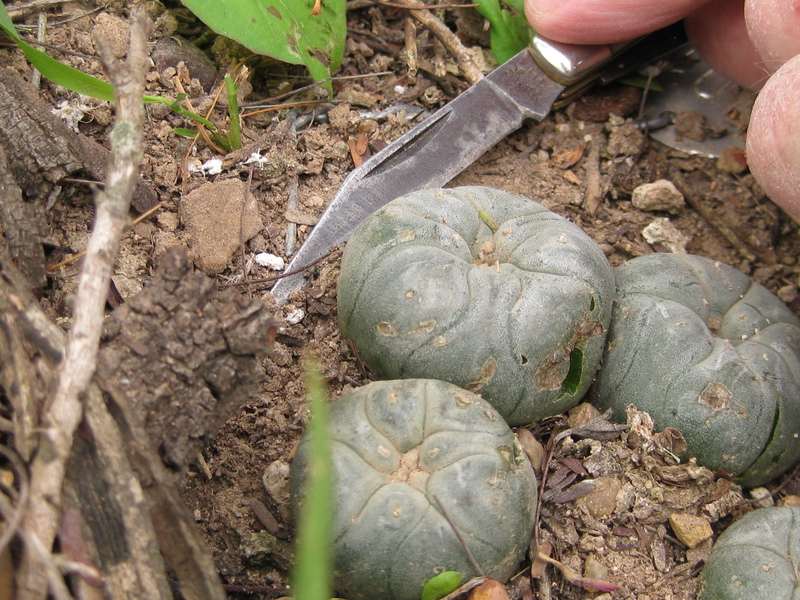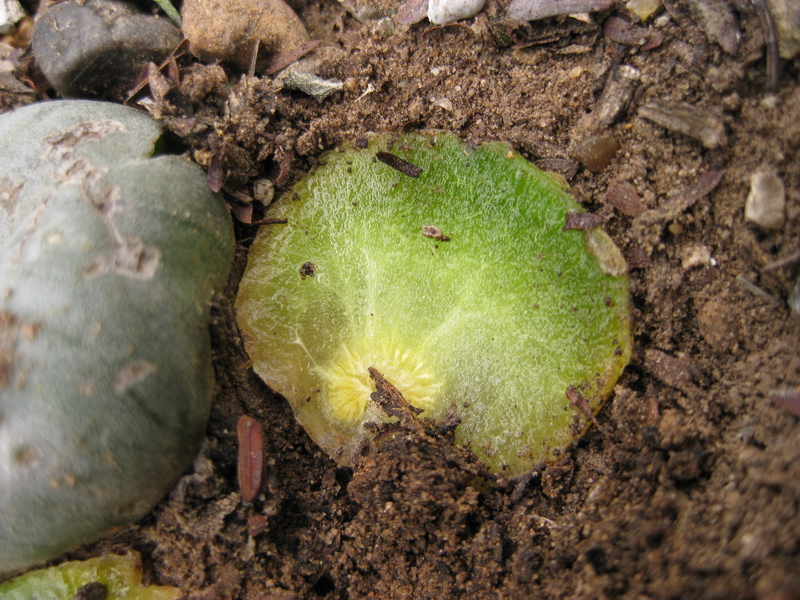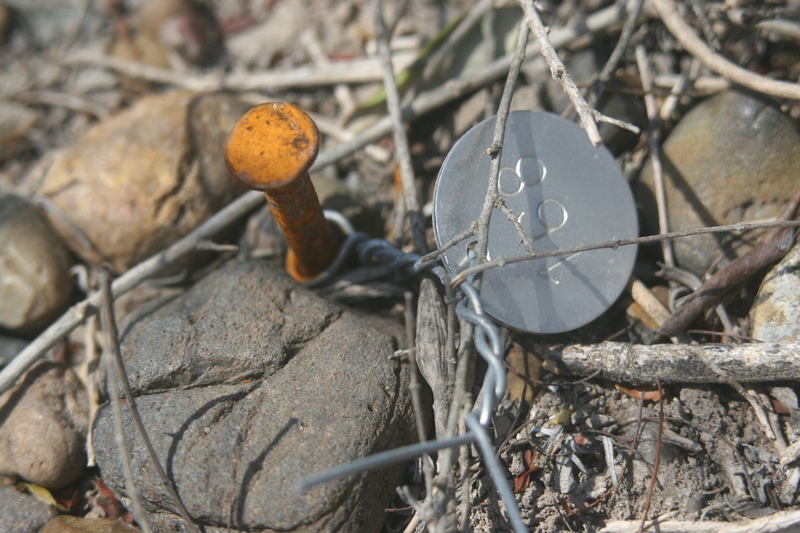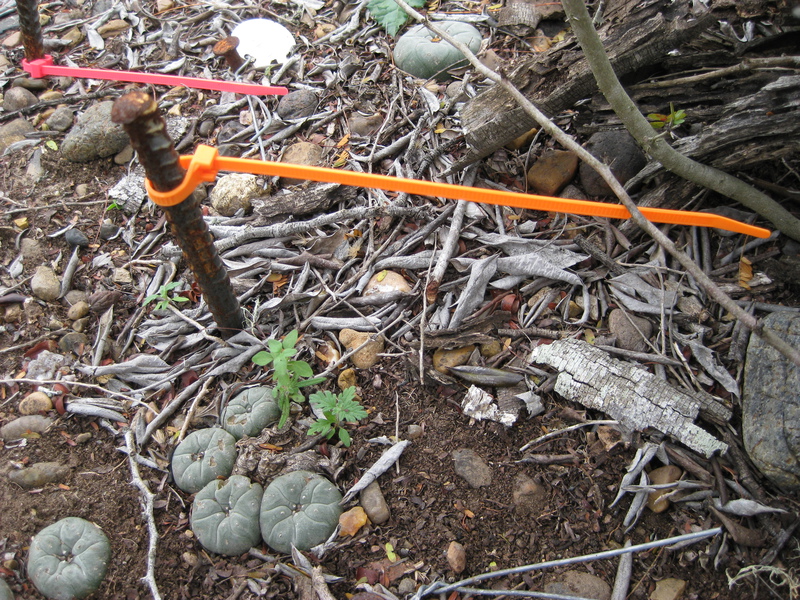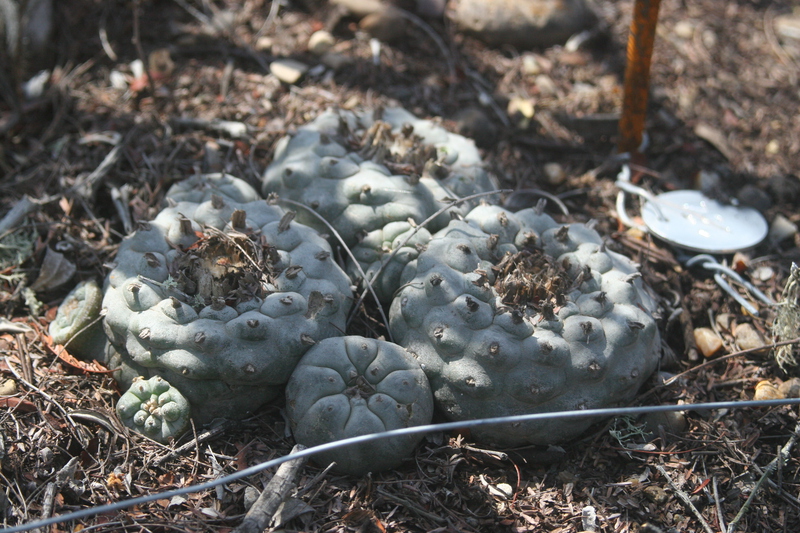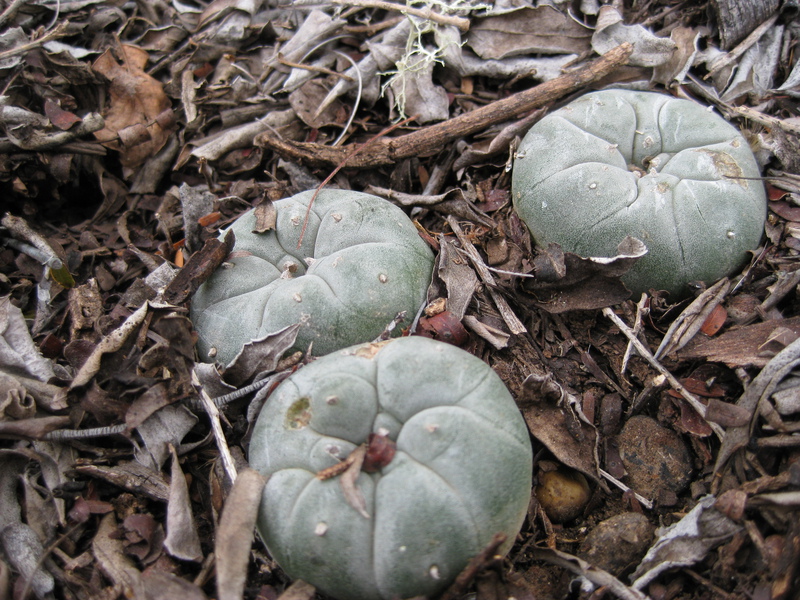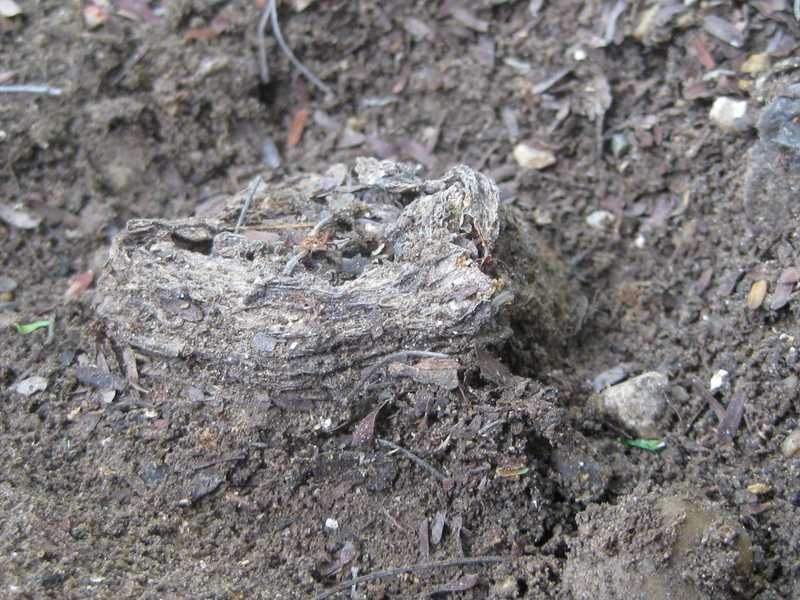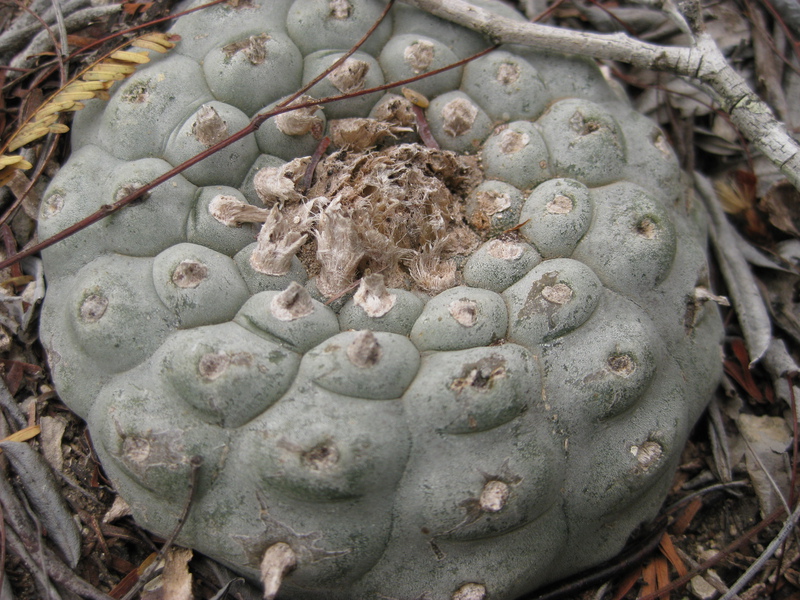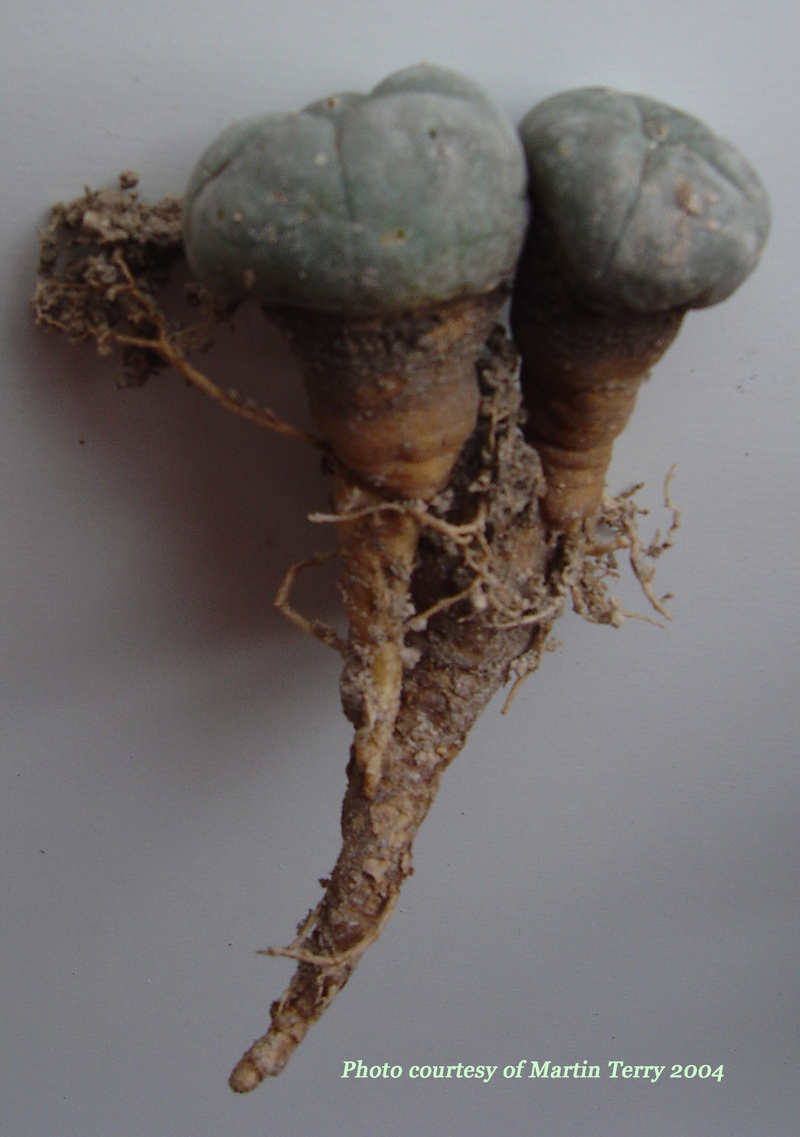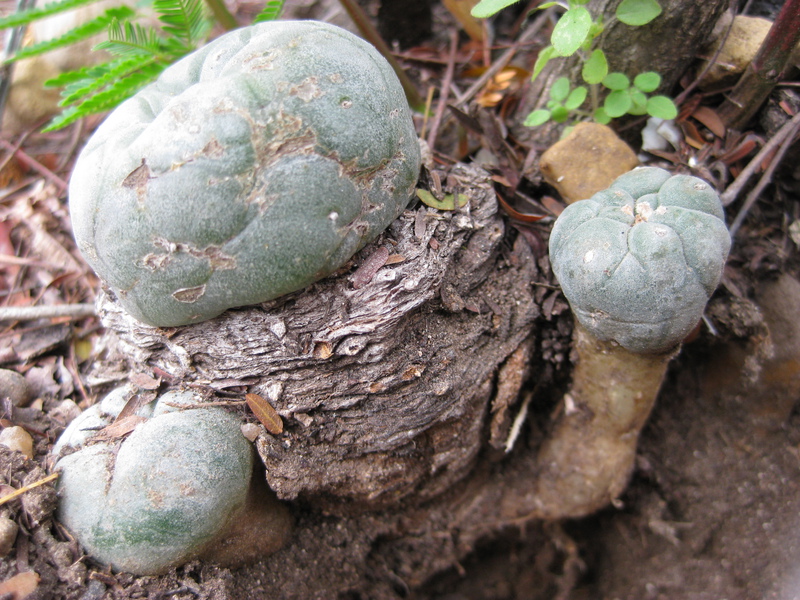Peyote Regrowth Following Proper Harvesting Practices
Jun 2011
Citation: Trout K, Norton B. "Peyote Regrowth Following Proper Harvesting Practices". Erowid Extracts. Jun 2011;20:8-11. Online edition: Erowid.org/plants/peyote/peyote_article5.shtml
Harvesting whole peyote cacti (Lophophora williamsii) using methods that collect part or all of the root is controversial, as it results in the death of this slow-growing plant. Although harvesting techniques that maximize plant survival chances have been known for years and were established in the literature in 2006 by Terry and Mauseth,1 many peyote harvesters use less careful techniques (such as cutting off the crown or "button" with a shovel). Some factions of the Native American Church (NAC) continue to use the root for making tea, killing the plant in the process. In contrast, harvesting the crown without significant damage to subterranean parts of the cactus can allow for the growth of new crowns in the future.
Despite declining peyote populations, no prior study has evaluated the impact of proper harvesting techniques on survival: how peyote responds to harvesting, how well it recovers, and the short- and long-term effects of harvesting on wild populations. In 2007, we at the Cactus Conservation Institute (CCI) undertook the first such study, focusing on plants growing in their natural habitat in a narrow zone in South Texas, home to peyote harvested legally for the NAC.
One group was left unharvested. The other was harvested with the technique described by Terry and Mauseth (2006): using a sharp, flat blade the crown (head) of the cactus was removed by making a horizontal cut along the surface of the ground, perpendicular to the stem/root, in order to produce a flat-cut surface nearly flush with the soil level. Half of the plants from which buttons had been harvested were covered with soil--by the NAC representative performing the harvests--in a traditional technique of the Coahuiltecan people. The Terry and Mauseth technique does not include covering the cut plant with soil and the NAC representative was asked to stop this practice after the research team noticed it being performed. The remaining half of the harvested plants was left to air-dry without cover.
On subsequent trips, the tagged plants were studied to monitor mortality, growth, and regrowth in unharvested versus harvested plants. Initially, the study was designed to last for four years--from first harvest to final measurement. After two years of regrowth, the researchers determined the four-year window would not be sufficient and the study protocol was revised to allow continued assessment until regrown buttons reached sexual maturity and a size compatible with sustainable harvesting.
The size and number of heads on each plant as well as the weights of the harvested crowns were recorded at the beginning of the study. On subsequent monitoring visits, the CCI team recorded the number and size of heads and information about missing, damaged, or dead plants. Details, including field measurements and color photographs of the tagged plants, can be found on the CCI website.4
The underground stem is where basal branching (branching from the base) most often originates, making it important for creating new crowns.1 The root itself is incapable of producing new crowns, so any plant that is cut below the stem tissue will die as soon as its food stores are depleted.
New heads are generated from the subterranean stem and extend up toward the sunlight until they surface next to the originating plant. Over time a new head can remain attached to the original stem or can go on to form its own taproot.
The investigators decided to score their two experimental groups in terms of "hog-related death" and "non-hog-related death". That arrangement proved an elegant solution, as feral hog activity had conveniently removed exactly two plants from the harvested group and two plants from the control group, leaving 48 plants in each. Harvested plants showed five non-hog-related deaths (10.4%) compared to one non-hog-related death in the control group (2.1%). This difference of four deaths in non-hog-related mortality between harvested and control groups was not statistically significant, meaning that the difference could be a result of random chance.
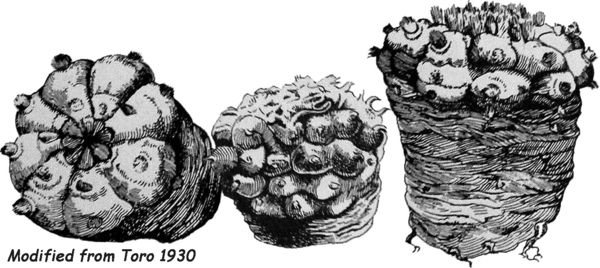
|
Methods
The research site was a private patch of land where peyote harvesting is not normally allowed; a rough, sloping area densely vegetated with thorny shrubs chosen for its existing wild peyote population. After obtaining the appropriate regulatory permits, the site was demarcated with zigzagging 17-gauge electric fence wire, secured to the ground with stakes, in a sampling method known as a "belt line transect". The CCI team labeled all peyote plants located within one meter of the wire with individually numbered tags. Two separate demarcation lines were run so that both groups included 50 peyote plants, matched as closely as possible for size and condition given the natural setting.One group was left unharvested. The other was harvested with the technique described by Terry and Mauseth (2006): using a sharp, flat blade the crown (head) of the cactus was removed by making a horizontal cut along the surface of the ground, perpendicular to the stem/root, in order to produce a flat-cut surface nearly flush with the soil level. Half of the plants from which buttons had been harvested were covered with soil--by the NAC representative performing the harvests--in a traditional technique of the Coahuiltecan people. The Terry and Mauseth technique does not include covering the cut plant with soil and the NAC representative was asked to stop this practice after the research team noticed it being performed. The remaining half of the harvested plants was left to air-dry without cover.
On subsequent trips, the tagged plants were studied to monitor mortality, growth, and regrowth in unharvested versus harvested plants. Initially, the study was designed to last for four years--from first harvest to final measurement. After two years of regrowth, the researchers determined the four-year window would not be sufficient and the study protocol was revised to allow continued assessment until regrown buttons reached sexual maturity and a size compatible with sustainable harvesting.
The size and number of heads on each plant as well as the weights of the harvested crowns were recorded at the beginning of the study. On subsequent monitoring visits, the CCI team recorded the number and size of heads and information about missing, damaged, or dead plants. Details, including field measurements and color photographs of the tagged plants, can be found on the CCI website.4
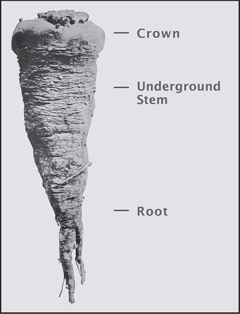
The root itself can be quite long. Photo by USDA botanist William Safford, 19163 |
What is the Root?
Colloquially, the entire underground portion of the plant--an ice-cream-cone-shaped structure that supports the small green crown on the top of the plant--is often referred to as its "root". But there is a third, important morphological division to the peyote plant, located between the crown and actual root, called the underground or subterranean stem. On older specimens, this corrugated brown section is usually the largest part of the plant. The best place to cut off the crown is near the top of this subterranean stem, in order to allow the remaining root and stem to grow new crowns.The underground stem is where basal branching (branching from the base) most often originates, making it important for creating new crowns.1 The root itself is incapable of producing new crowns, so any plant that is cut below the stem tissue will die as soon as its food stores are depleted.
New heads are generated from the subterranean stem and extend up toward the sunlight until they surface next to the originating plant. Over time a new head can remain attached to the original stem or can go on to form its own taproot.
Feral Hog Disturbance
Feral hogs were a source of ground disturbance and peyote death in both the harvested and control groups. The hogs did not eat the peyote, but rather appeared to be foraging around the roots of the shrubbery that served as peyote nurse plants. A "nurse plant" is a plant of another species that, by virtue of the shade it creates, provides a moister, cooler, slightly less-exposed microhabitat that promotes the germination of cactus seed and the survival of the vulnerable seedlings during their critical first year of growth. The hogs' digging variously broke, dug up, or simply buried some peyote plants.The investigators decided to score their two experimental groups in terms of "hog-related death" and "non-hog-related death". That arrangement proved an elegant solution, as feral hog activity had conveniently removed exactly two plants from the harvested group and two plants from the control group, leaving 48 plants in each. Harvested plants showed five non-hog-related deaths (10.4%) compared to one non-hog-related death in the control group (2.1%). This difference of four deaths in non-hog-related mortality between harvested and control groups was not statistically significant, meaning that the difference could be a result of random chance.
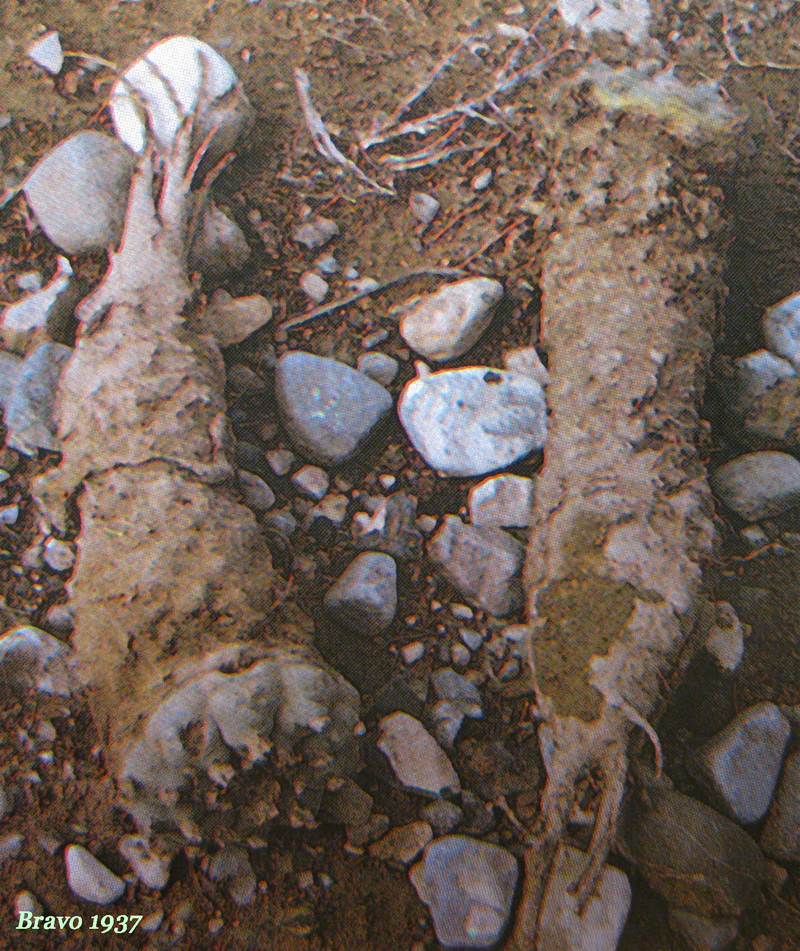
almost half the length of the plant. Photo by Bravo, 19375 |
Post-Harvest Soil Treatment
There were two groups of harvested plants: soil-covered and non-soil-covered. Hogs had killed one plant in each of these groups, leaving 24 per group. In the soil-treated group there were four deaths (out of 24 plants) compared to one death (out of 24) in the plants not covered with soil following harvest. Because this difference was not large enough to be statistically significant, further study with larger test groups is necessary to determine the effect of Coahuiltecan-style post-harvest soil covering on plant mortality.Size and Number of Crowns
After mortality, the next most important consideration was the number and size of crowns on the peyote rootstocks in the harvested and non-harvested groups. As expected, the unharvested control group had much larger heads on average, but with fewer crowns at two years. The unharvested group had 80 total crowns on surviving plants (an average of 1.7 crowns per surviving plant), while the harvested group had 111 crowns (2.6 crowns per surviving plant).Preliminary Findings
This is an early report on the progress of ongoing research, and all findings are preliminary. At the two-year point, 2 out of 50 plants were killed by hogs in both harvested and unharvested groups. In the harvested group, 5 non-hog-related deaths occurred compared to 1 in the unharvested group. The harvested group had 111 live crowns, with only 80 in the unharvested group. Crowns on harvested plants were smaller than on unharvested plants. The increase in the number of peyote crowns available for future harvests, despite an increase in plant mortality, suggests that proper harvesting practices might offer a sustainable way to harvest usable peyote buttons as long as time sufficient for growth is allowed between harvests.References #
- Terry M, Mauseth JD. "Root-Shoot Anatomy and Post-Harvest Vegetative Clonal Development in Lophophora williamsii (Cactaceae:Cactaea): Implications for Conservation". SIDA. 2006. 22(1):565-92.
- Toro A. 1930. "Las Plantas Sagradas del los Aztecas y Su Influencia Sobre el Arte Precortesiano". Proceedings of the Twenty-Third International Congress of Americanists. New York. Sep 17-22, 1928. 101-21.
- Safford WE. "Narcotic Plants and Stimulants of the Ancient Americans". Annual Report of the Smithsonian Institution. 1916. 387-424.
- Cactus Conservation Institute. "Peyote Harvest Regrowth: Summary of Our Observations 2008-2011". CCI. Cactusconservation.org/CCI/regrowth.html. 2011.
- Bravo H. Las Cactáceas de México Vol. 1. Instituto de Biología de la Universidad Nacional de México. 1937.



